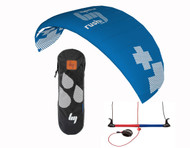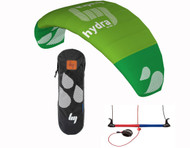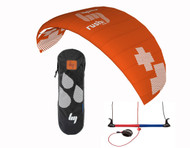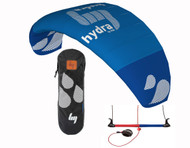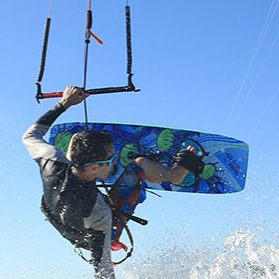
I'm new! I'm looking for a trainer kite...
I'm looking for a beginner, entry-level power kite for...
I'm looking for a board...
- Home
- Trainer Kites
- LEARNING CENTER
- How to Use a Trainer Kite

Categories
Shop by Price
Brands
Current Top Sellers
-
$279.00

-
$389.99$379.99
-
$349.99

-
$439.99$435.45
-
$348.50$345.50
How to Use a Trainer Kite

(See our Trainer Kite Reviews to see our specific trainer kites and find the best fit for you!)
How to Keep Your Kite Healthy
Keeping your kite healthy is a simple task.
All the kites we carry are top quality and will withstand a reasonable amount of crashing and strong winds. Here are some suggestions to extending the life of your kite.
- Keep out of the sun when not using.
- Put your kite away dry and not wet or damp
- Keep your kite out of the trees or away from objections that will cause damage.
- Learn how not to crash your kite.
Practice Releasing the Control-Bar
This will help keep you safe and your kite intact. What happens if your car hits something while traveling slowly?
Maybe nothing, a scratch, small dent?
What happens if do the exact same thing when moving fast?
Damage!
Apply that same common sense to using your kite.
If your kite is racing toward the ground... Release your control-bar, and avoid a power-slam!
Releasing the bar will reduce or prevent damage to you and your kite.
- cut the power. ( like taking your foot of the gas)
- slow it down, and
- put your kite in reverse (if it's a 3-line trainer)
One question pop-quiz... ready?
Your kite is flying fast toward the ground.
Do you....
A. Hold on with a monkey-grip and hope for the best.
or
B. Open your hands and release your control-bar?
Yes, B, is correct. If in doubt?... let out! Release.
It's super important to physically practice... "RELEASING" you control bar.
Steering a Kite
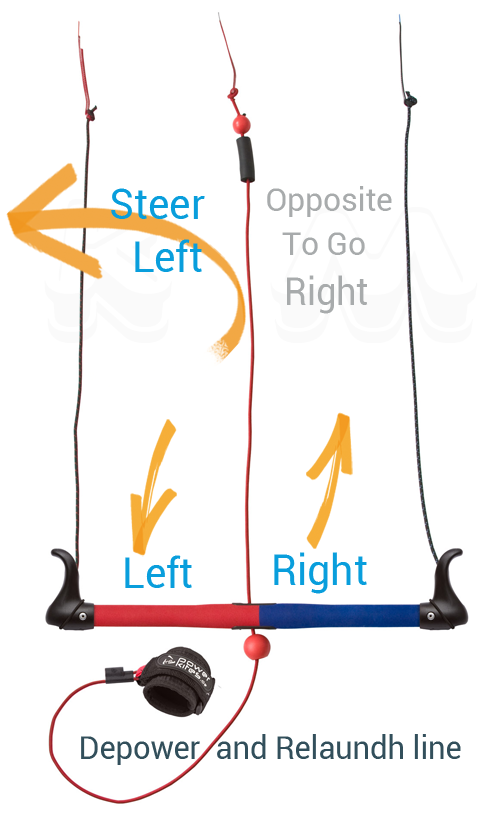 Steering a trainer kite is very much like steering a mountain bike, or a wave-runner, it's a push-pull movement, keeping the bar level to the ground. One arm extends, and the other arm bends.
Steering a trainer kite is very much like steering a mountain bike, or a wave-runner, it's a push-pull movement, keeping the bar level to the ground. One arm extends, and the other arm bends.
A Common Mistake is tilting/ turning the bar, hand over hand, like a cars steering wheel ... No, no.
Think STEER like a "MOUNTAIN BIKE" or boxing:
One arm in and one arm out.
To steer your kite to the right...
Pull-in with your right hand, (bending your right arm).
As your right hand comes in, be sure to let-out, or push-out, your opposite hand.
This works because as you pull in on one side, you are shortening the line on that side, causing that side of your kite to slow down, and allowing the other wing-tip to speed-up causing the kite to turn / pivot around that tip.
One hand IN, and the other hand OUT
In the event your kite becomes damaged you can always send it to a Kite Repair Shop.
Video Instruction Guides
When watching how-to kite videos, the specific kite model demonstrated is not too important since many kites utilize similar set-ups.
Example:
- Any kite video showing a 3-line kite would be relevant to other 3-line kite models.
- All kite videos, 2-line to 5-line, would still have info that pertains to all kites.
Video: Flying The Rush V Pro Trainer Kites
Video: Trainer-Kite Boot Camp.
This is a great video by Best Kiteboarding with a 2 line trainer kite. This youtube video emphasizes important basic kite flying concepts.
- Find an open area
- Feeling the wind, looking for indicators, understanding the wind-window
- Weighting the trailing-edge
- Un-wrapping, and un-twisting your lines
- Stance, knees bent
- Flying patterns
Video: User Guide for the HQ Rush IV "3-Line" Trainer-Kite.
In the video above "Boot-Camp" they use small rocks to hold the kite down. In this next video, the kiters using a ground-stake to secure the kite via the leash. Using Sand on the trailing edge is another option.
Video: Hydra Video Manual
You don't have a Hydra kite?... It doesn't matter. The basics are the same for all 3-line trainer kites.
Video: How to Snowkite - featuring the HQ Scout 3-Line Kite.
Take notice of how the kiters move their kites quickly to generate more power, and move the kite less when they have sufficient power.
Once again, whether you are on a beach, in a field, or on the snow, these videos are all helpful to learn and then master the basic concepts of kiting.
 Loading... Please wait...
Loading... Please wait...



